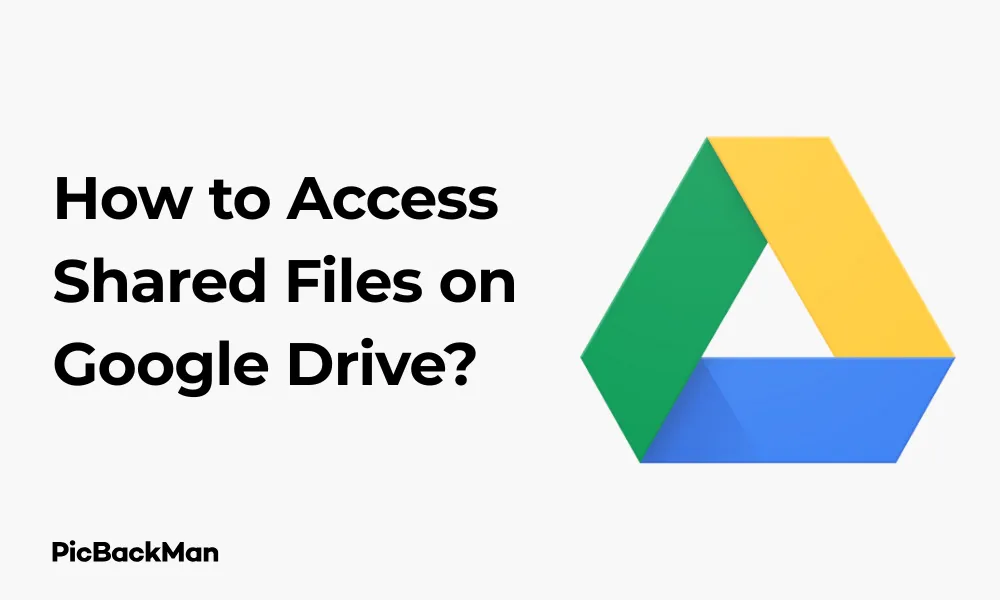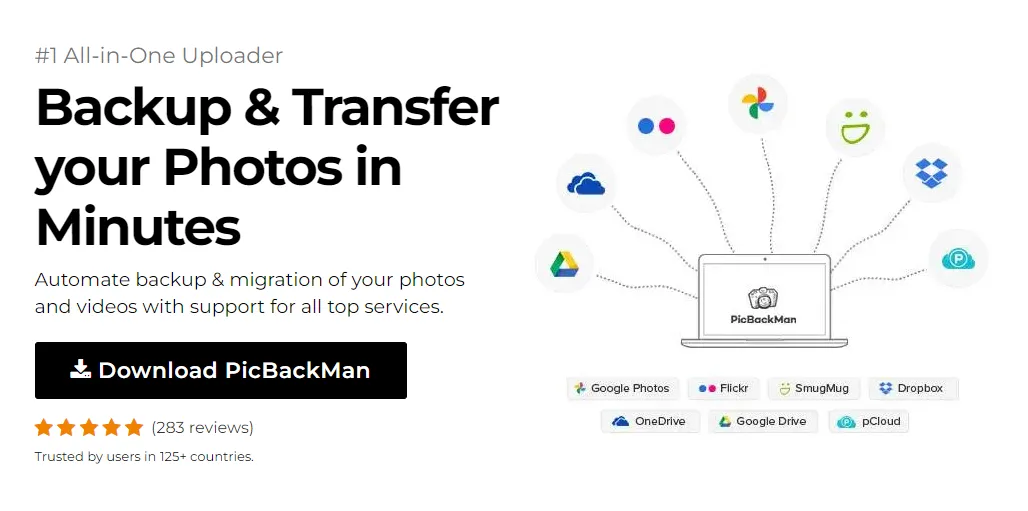
Why is it the #1 bulk uploader?
- Insanely fast!
- Maintains folder structure.
- 100% automated upload.
- Supports RAW files.
- Privacy default.
How can you get started?
Download PicBackMan and start free, then upgrade to annual or lifetime plan as per your needs. Join 100,000+ users who trust PicBackMan for keeping their precious memories safe in multiple online accounts.
“Your pictures are scattered. PicBackMan helps you bring order to your digital memories.”
How to Access Shared Files on Google Drive?


Google Drive has become one of the most popular cloud storage services, allowing users to store and share files easily. Whether you're collaborating on a project with colleagues, sharing photos with family, or accessing documents across multiple devices, knowing how to access shared files on Google Drive is essential. This guide will walk you through various methods to find and open files that others have shared with you.
Finding Shared Files on Google Drive
When someone shares a file or folder with you on Google Drive, you have several ways to access it. Let's explore each method in detail.
Method 1: Using the "Shared with me" section
The most straightforward way to find files shared with you is through the dedicated “Shared with me” section in Google Drive.
- Open Google Drive by visiting drive.google.com and sign in to your Google account
- Look at the left sidebar menu
- Click on "Shared with me"
- Browse through the list of files and folders shared with you
Files in this section are typically arranged by the date they were shared with you, with the most recent ones appearing at the top. You can sort them differently by clicking the "Last modified" dropdown menu and selecting your preferred sorting option.
Method 2: Using the Search Function
If you're looking for a specific shared file but can't find it easily in the "Shared with me" section, the search function can help.
- Click on the search bar at the top of Google Drive
- Type the name of the file or keywords related to it
- Press Enter or click the search icon
- To narrow down results to only shared files, click on the “Search options” icon (looks like a filter) on the right side of the search bar
- Select “Shared with me” under the “Location” dropdown
- Click "Search" to see filtered results
This method is particularly helpful when you have many shared files and need to find something specific quickly.
Method 3: Accessing via Email Notification
When someone shares a file with you, you typically receive an email notification (unless they've disabled this option).
- Open your email inbox
- Find the email notification about the shared file (usually from Google Drive)
- Click on the file name or the “Open” button in the email
- The file will open directly in Google Drive
This method provides the quickest access to newly shared files, especially if you check your email regularly.
Understanding Different Sharing Permissions
When accessing shared files, it's important to understand that you might have different permission levels depending on what the file owner has granted you.
Types of Permissions
| Permission Level | What You Can Do |
|---|---|
| Viewer | Open and read the file but cannot make changes |
| Commenter | View the file and add comments but cannot edit the content |
| Editor | View, comment on, and make changes to the file |
You can check your permission level by opening the file and looking at the sharing status icon near the file name. If you need additional permissions, you'll need to request them from the file owner.
Organizing Shared Files
As you accumulate more shared files, organizing them becomes important for easy access later.
Adding Shared Files to "My Drive"
To keep important shared files easily accessible, you can add them to your own Drive:
- Find the shared file in the “Shared with me” section
- Right-click on the file
- Select "Add shortcut to Drive"
- Choose the folder in your Drive where you want to add the shortcut
- Click "Add shortcut"
This creates a shortcut to the shared file without making a copy, so any updates to the original file will be reflected in your shortcut.
Creating Folders for Shared Files
You can create dedicated folders to organize shortcuts to shared files:
- In your Google Drive, click the "+ New" button
- Select "Folder" and give it a name (eg, "Work Shared Files")
- Find shared files in "Shared with me"
- Right-click on each file you want to organize
- Select "Add shortcut to Drive"
- Choose your newly created folder
This method helps you group related shared files together for better organization.
Accessing Shared Files on Mobile Devices
Google Drive is available on mobile devices, allowing you to access shared files on the go.
Using the Google Drive App
- Download and install the Google Drive app from your device's app store if you haven't already
- Open the app and sign in to your Google account
- Tap on the menu icon (three horizontal lines) in the top-left corner
- Select "Shared with me"
- Browse through your shared files
The mobile app offers most of the same functionality as the web version, including searching for specific files and organizing them.
Offline Access to Shared Files
To access shared files without an internet connection:
- Open the Google Drive app on your mobile device
- Find the shared file you want to access offline
- Tap the three-dot menu icon next to the file
- Toggle on "Available offline"
The file will download to your device, allowing you to view it even without an internet connection. Keep in mind that you won't be able to see any updates made to the file until you're back online.
Troubleshooting Access Issues
Sometimes you might encounter problems accessing shared files. Here are some common issues and their solutions.
File Not Showing Up in "Shared with me"
If you can't find a file that someone claims to have shared with you:
- Check your email for the sharing notification and access the file directly from there
- Ask the person who shared the file to verify they used your correct email address
- Make sure you're signed in to the correct Google account
- Try searching for the file by name in Google Drive
- Ask the person to share the file again
Permission Denied Errors
If you receive a "You need permission" message when trying to access a shared file:
- Verify you're signed in to the correct Google account
- Click the "Request access" button if available
- Contact the file owner to ensure they've granted you the proper permissions
- Check if the sharing link requires a password or has expired
File Loading Issues
If a shared file is taking too long to load or won't open:
- Check your internet connection
- Try refreshing the page
- Clear your browser cache and cookies
- Try accessing the file from a different browser or device
- If the file is very large, it might take longer to load
Collaborating on Shared Files
One of the greatest benefits of Google Drive is the ability to collaborate with others in real-time.
Commenting on Shared Files
If you have at least commenter permissions:
- Open the shared file
- Highlight the text or section you want to comment on
- Right-click and select “Comment” or click the comment icon that appears
- Type your comment and press "Comment" to save it
Others with access to the file will see your comments and can reply to them.
Editing Shared Files
If you have editor permissions:
- Open the shared file
- Make your changes directly in the document
- All changes are saved automatically
Multiple people can edit a file simultaneously, with each person's cursor shown in a different color.
Tracking Changes and Version History
To see who made what changes to a shared file:
- Open the file in Google Drive
- Click on "File" in the top menu
- Select "Version history" and then "See version history"
- A panel will open showing all changes made to the document, when they were made, and by whom
- Click on any version to see the document as it appeared at that time
This feature is particularly useful for collaborative projects where multiple people are making changes.
Sharing Files from Your Drive with Others
While this guide focuses on accessing files shared with you, it's also helpful to know how to share your own files with others.
Basic File Sharing
- Right-click on the file you want to share in your Drive
- Select "Share"
- Enter the email addresses of the people you want to share with
- Choose their permission level (Viewer, Commenter, or Editor)
- Add an optional message
- Click "Send"
Creating Shareable Links
- Right-click on the file and select "Share"
- Click on "Get link" or "Change to anyone with the link"
- Set the permission level for anyone who uses the link
- Copy the link and share it via email, messaging apps, or social media
Sharing with Non-Google Users
You can share files with people who don't have Google accounts by adjusting the sharing settings:
- When sharing the file, click the gear icon in the sharing dialog
- Uncheck "Require sign-in"
- Click "Save"
This allows anyone with the link to access the file without signing in to a Google account.
Managing Notifications for Shared Files
Staying updated on changes to shared files is important for effective collaboration.
Setting Up Notifications
- Open the shared file
- Click on the "Comments" button (speech bubble icon) in the upper-right corner
- Click on "Notifications"
- Choose your preferred notification level:
- "All" - get notified about all comments and changes
- "Only yours" - get notified only when someone replies to your comments or mentions you
- "None" - turn off notifications for this file
Email Notification Settings
To manage email notifications for all shared files:
- Go to Google Drive settings by clicking the gear icon in the upper-right corner
- Select "Settings"
- Scroll to the “Notifications” section
- Check or uncheck options based on your preferences
- Click "Done" to save your changes
Security Considerations for Shared Files
When accessing and working with shared files, keeping security in mind is important.
Checking Who Has Access
To see everyone who has access to a shared file:
- Open the file
- Click the “Share” button in the upper-right corner
- The sharing dialog will show all users who have access and their permission levels
Protecting Sensitive Information
When working with shared files containing sensitive information:
- Don't download shared files to public or shared computers
- Be cautious about editing sensitive information on public networks
- Sign out of your Google account when using someone else's device
- Consider using two-factor authentication for your Google account
Reporting Abuse
If you receive inappropriate shared content:
- Open the file
- Click on the three-dot menu in the upper-right corner
- Select "Report abuse"
- Choose the type of abuse and provide details
- Submit the report
Quick Tip to ensure your videos never go missing
Videos are precious memories and all of us never want to lose them to hard disk crashes or missing drives. PicBackMan is the easiest and simplest way to keep your videos safely backed up in one or more online accounts.
Simply download PicBackMan (it's free!) , register your account, connect to your online store and tell PicBackMan where your videos are - PicBackMan does the rest, automatically. It bulk uploads all videos and keeps looking for new ones and uploads those too. You don't have to ever touch it.
Advanced Features for Shared Files
Google Drive offers several advanced features for working with shared files.
Using Google Drive File Stream for Desktop
For easier access to shared files on your computer:
- Download and install Google Drive for desktop from Google's website
- Sign in with your Google account
- Your Drive files, including those shared with you, will appear as a drive on your computer
- Access shared files through the “Shared with me” folder
Converting File Formats
To convert a shared file to a different format:
- Open the file in Google Drive
- Click on "File" in the top menu
- Select "Download as"
- Choose your preferred format (PDF, Word, Excel, etc.)
Working with Multiple Shared Files
To perform actions on multiple shared files at once:
- In the "Shared with me" section, hold Ctrl (or Cmd on Mac) while clicking on multiple files
- Right-click on any selected file to see available actions
- Choose an action like "Add shortcut to Drive," "Download," or "Make a copy"
Frequently Asked Questions
1. Can I access shared files on Google Drive without an internet connection?
Yes, you can access shared files offline by marking them as “Available offline” in the Google Drive mobile app or by using Google Drive for desktop with offline sync enabled. However, you need to set this up while you have an internet connection, and any changes made offline will sync when you reconnect.
2. What happens to my access when someone stops sharing a file with me?
When someone revokes your access to a shared file, you'll no longer be able to open it. If you had added a shortcut to the file in your Drive, the shortcut will remain but will show an error when clicked. Any offline copies you may have downloaded will still be accessible, but they won't receive any further updates.
3. How can I tell if someone has viewed a file I shared with them?
Google Drive doesn't provide a built-in way to see if someone has viewed a file you've shared. However, for Google Docs, Sheets, and Slides, you can check the version history to see if the person has made any edits or comments. For more detailed tracking, you might need to use third-party add-ons or tools.
4. Is there a limit to how many files can be shared with me on Google Drive?
There's no specific limit to how many files can be shared with you. However, your overall Google Drive storage limit (typically 15GB for free accounts, shared across Gmail, Drive, and Photos) applies to files you own, not files shared with you. Shared files count against the owner's storage quota, not yours.
5. Can I transfer ownership of a shared file to someone else?
Only the owner of a file can transfer ownership, and only to someone within the same organization if using Google Workspace. If you're the owner, you can transfer ownership by sharing the file, clicking the dropdown next to the person's name, and selecting "Make owner." Once you transfer ownership, you'll become an editor of the file unless the new owner changes your permissions.
Conclusion
Accessing shared files on Google Drive is a straightforward process once you understand the various methods available. Whether you prefer using the “Shared with me” section, searching for specific files, or accessing them via email notifications, Google Drive makes collaboration easy and efficient. By organizing your shared files effectively and understanding the different permission levels, you can make the most of Google Drive's sharing capabilities.
Remember that Google Drive is constantly evolving, so some features and interfaces may change over time. However, the core functionality of accessing and working with shared files remains consistent. With the knowledge gained from this guide, you'll be well-equipped to navigate shared files on Google Drive and collaborate effectively with others.






